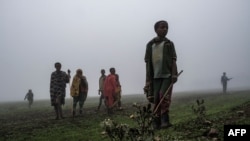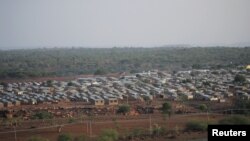Aid groups say Eritrean refugees in Ethiopia are facing increased attacks and growing hunger as humanitarian access to the displaced persons camps remains limited. The aid groups are calling on Ethiopian authorities to protect refugees and allow much-needed assistance into besieged areas of the country.
Eritrean refugees living in Ethiopia continue to face hunger and attacks as fighting in the country’s northern areas continues.
According to refugees who spoke to the U.N. Office for the Coordination of Humanitarian Affairs, OCHA, unidentified men attacked the Barahle camp last month, killing five people.
Faith Kasina is the U.N. refugee agency spokesperson for Eastern Africa, the Horn of Africa, and the Great Lakes region.
She says Eritrean refugees are fleeing conflict areas to safer areas.
“The conflict has also reached some of those refugee camps in those three regions where we have seen refugees being displaced, forced to flee yet again," said Kasina. "Others have been wounded and some have also been killed. The situation continues to be extremely worrying for refugees, particularly because a lot of them have to deal with the reality of being forced to flee yet again.”
Ethiopia hosts at least 140,000 Eritreans who fled persecution and other abuses in their country.
Most of the refugees are sheltered in the Tigray region, scene of the heaviest fighting between Ethiopia’s government forces and the Tigray Liberation People’s Front rebel group. Others have moved south to the Afar and Amhara regions, where the TPLF is battling pro-government militias.
Humanitarian agencies have had difficulty accessing the populations in need because of roadblocks and insecurity.
The U.N. humanitarian office says it was recently able to distribute 100 metric tons of healthcare and nutrition supplies to Tigray. The aid helped about 10,000 people and at least 22,000 refugees.
Another 190,000 received assistance in Afar and Amhara.
Kasina of the U.N. refugee agency says more people are left without shelter.
“With the deterioration of the security situation and the ongoing conflict many people, including refugees, are likely to be further displaced to flee their homes or where they are living in settlement in urban areas to other areas that are relatively safer in search of assistance, in search of security," said Kasina.
Amnesty International Horn of Africa researcher Fisseha Tekle says some Eritrean refugees are leaving Ethiopia altogether.
“A number of Eritreans are leaving to other countries especially through Kenya border to Uganda," said Tekle. "Most of them while en route they are arrested by police officials at the border or after crossing the border and many of the times they are taken to court and fined especially in Kenya though some of them were able to make it to Uganda.”
The U.N. humanitarian agency says its operations in the north of the country continue to be restricted, at a time when about 870,000 people need its assistance each week.








